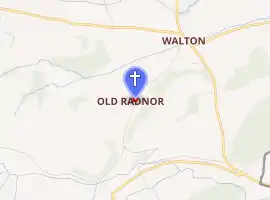St Stephen's Church, Old Radnor
St Stephen's Church is a Church of England parish church in Old Radnor, Powys, Wales.[1] It was constructed in the 15th century in perpendicular gothic style on the site of a 6th-century church. Although much restored and rebuilt, it may have the oldest church organ in the United Kingdom; the organ case, although later, is also very early.[2] It is a grade I listed building.[3]
| St Stephen's Church | |
|---|---|
| Church of St Stephen | |
 | |

| |
| Denomination | Church of England |
| Previous denomination | Roman Catholic |
| History | |
| Former name(s) | St Ystyffan's church |
| Status | active |
| Architecture | |
| Heritage designation | Grade I |
| Designated | 1993 |
| Administration | |
| Parish | Old Radnor |
| Diocese | Diocese of Hereford |
History
Since there is no other church of St Stephen in Wales, it is speculated that the original church might have been dedicated to Ystyffan, a member of the royal family of the Kingdom of Powys, with a number of churches dedicated to him. Following the Norman conquest of Wales, the Normans might have incorrectly believed that Ystyffan was a Welsh reference to Saint Stephen and rededicated the church to the Protomartyr as he was a popular saint with the Normans.[2] In the 1200s, the church was transferred to the Mortimer Family. In 1401 it was destroyed after being burned during the Glyndŵr Rising. Despite the fire, the very large pre-Norman baptismal font, which might be as old as 8th century, survived.[4] It was rebuilt shortly afterwards and the font reinstalled. The new church building was reconstructed with embrasures in the merlons on the parapet, which has led to suggestions that it was intended to be a fortified church. However, beyond the embrasure which was uncommonly used for decoration, there is nothing else on the building that suggested that it was fortified.[3] When it was reconstructed alongside the high altar, there was room for five chantry altars, though one was later shut off to become the vestry.[5] In 1993, the church was granted Grade I listed status.[6]
In the 15th century, a new stained glass window was installed in the church featuring Saint Catherine. Also installed in the church at the time were symbols relating to King Edward IV of England including the White Rose of York and the Black Bull of the Duke of Clarence.[2] In the 16th century, the church underwent renovations with tributes to the House of Tudor. New choir stalls were installed and a new roof was fitted over the nave with Tudor Roses. A new Welsh tracery was also installed during this time.[6] The rood screen is also notably fine.[7]
Organ
St Stephen's Church is reported to have the oldest organ in the British Isles, potentially dating originally to the 15th century, though Cadw states that it is not in its original form.[8] The organ's case dates to the 16th century, and there are suggestions that it was installed before the Dissolution of the Monasteries, which makes it one of the earliest surviving organ cases.[2] It has been suggested by historians that future composer and organist of several cathedrals, John Bull learned to play the organ on the one at St Stephen's Church.[2] It was later restored in 1872 by F. H. Sutton, who installed new organ pipes and linenfold panels.[9] Though it is not known why such an organ was installed in a village church, it has been stated that its remote location was a contributing factor to its state of survival.[9]
Churchyards
The main churchyard contains a war grave of a Machine Gun Corps soldier of World War I,[10] and the churchyard extension one of a Manchester Regiment soldier of World War II.[11]
Referendum
In 1914, the Welsh Church Act 1914 was passed by the Parliament of the United Kingdom to disestablish the Church in Wales from the Church of England. Owing the enactment being delayed by the Suspensory Act 1914, nineteen parishes (including Old Radnor) were balloted by the Welsh Church Commissioners in a referendum as to whether they wanted remain part of the Church of England or join the Church in Wales. This was because their parish boundaries crossed the geographical borders between England and Wales. St Stephen's parishioners voted 344–99 to remain part of the Church of England despite the church being located in Wales.[12] As a result of the decision in the referendum, St Stephen's Church remained a part of the Diocese of Hereford.[1]
References
- "Old Radnor: St Stephen, Old Radnor – Diocese of Hereford". Church of England. 2011-02-02. Retrieved 2016-04-16.
- "Old Radnor, St Stephen Church, History & Visiting Information". Historic Wales Guide. Retrieved 2016-04-16.
- Philip Davis (2016-02-01). "Old Radnor Church of St Stephen". Gatehouse Gazetteer. Retrieved 2016-04-16.
- "Wales: Walking in border country". Telegraph. 1999-07-10. Retrieved 2016-04-16.
- Grigson, Geoffrey (2009). "V". The Shell Country Alphabet: The Classic Guide to the British Countryside. Penguin UK. ISBN 0141041684.
- Good Stuff (1993-02-15). "Parish Church of St Stephen – Old Radnor – Powys – Wales". British Listed Buildings. Retrieved 2016-04-16.
- http://www.castlewales.com/oldrdch.html
- "Parish Church of St Stephen". Cadw. Retrieved 2016-04-16. Cite journal requires
|journal=(help) - Bicknell, Stephen (1999). The History of the English Organ. Cambridge University Press. p. 43. ISBN 0521654092.
- https://www.cwgc.org/find-war-dead/casualty/2847389/jones,-evan-watkin-powell/
- https://www.cwgc.org/find-war-dead/casualty/2965149/davies,-lewis/
- "Welsh Church Bill (Balloting)". Hansard. 1915-03-02. Retrieved 2016-04-16.